The NVIDIA GeForce GTX 750 Ti and GTX 750 Review: Maxwell Makes Its Move
by Ryan Smith & Ganesh T S on February 18, 2014 9:00 AM ESTPower, Temperature, & Noise
As always, last but not least is our look at power, temperature, and noise. Next to price and performance of course, these are some of the most important aspects of a GPU, due in large part to the impact of noise. All things considered, a loud card is undesirable unless there’s a sufficiently good reason – or sufficiently good performance – to ignore the noise.
| GeForce GTX 750 Series Voltages | ||||
| Ref GTX 750 Ti Boost Voltage | Zotac GTX 750 Ti Boost Voltage | Zotac GTX 750 Boost Voltage | ||
| 1.168v | 1.137v | 1.187v | ||
For those of you keeping track of voltages, you’ll find that the voltages for GM107 as used on the GTX 750 series is not significantly different from the voltages used on GK107. Since we’re looking at a chip that’s built on the same 28nm process as GK107, the voltages needed to drive it to hit the desired frequencies have not changed.
| GeForce GTX 750 Series Average Clockspeeds | |||||
| Ref GTX 750 Ti | Zotac GTX 750 Ti | Zotac GTX 750 | |||
| Max Boost Clock |
1150MHz
|
1175MHz
|
1162MHz
|
||
| Metro: LL |
1150MHz
|
1172MHz
|
1162MHz
|
||
| CoH2 |
1148MHz
|
1172MHz
|
1162MHz
|
||
| Bioshock |
1150MHz
|
1175MHz
|
1162MHz
|
||
| Battlefield 4 |
1150MHz
|
1175MHz
|
1162MHz
|
||
| Crysis 3 |
1149MHz
|
1174MHz
|
1162MHz
|
||
| Crysis: Warhead |
1150MHz
|
1175MHz
|
1162MHz
|
||
| TW: Rome 2 |
1150MHz
|
1175MHz
|
1162MHz
|
||
| Hitman |
1150MHz
|
1175MHz
|
1162MHz
|
||
| GRID 2 |
1150MHz
|
1175MHz
|
1162MHz
|
||
| Furmark |
1006MHz
|
1032MHz
|
1084MHz
|
||
Looking at average clockspeeds, we can see that our cards are essentially free to run at their maximum boost bins, well above their base clockspeed or even their official boost clockspeed. Because these cards operate at such a low TDP cooling is rendered a non-factor in our testbed setup, with all of these cards easily staying in the 60C or lower range, well below the 80C thermal throttle point that GPU Boost 2.0 uses.
As such they are limited only by TDP, which as we can see does make itself felt, but is not a meaningful limitation. Both GTX 750 Ti cards become TDP limited at times while gaming, but only for a refresh period or two, pulling the averages down just slightly. The Zotac GTX 750 on the other hand has no such problem (the power savings of losing an SMX), so it stays at 1162MHz throughout the entire run.

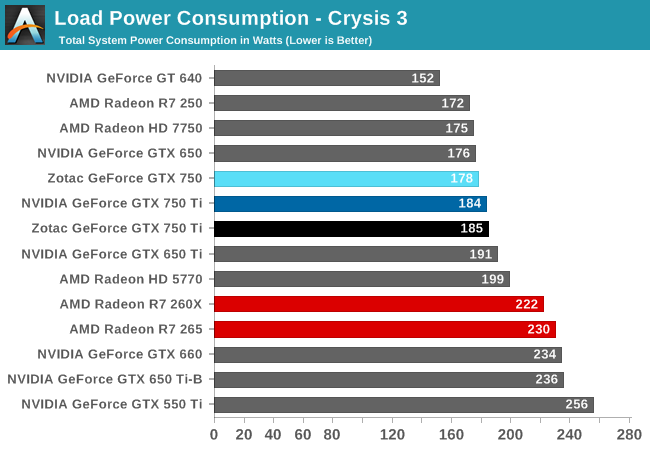
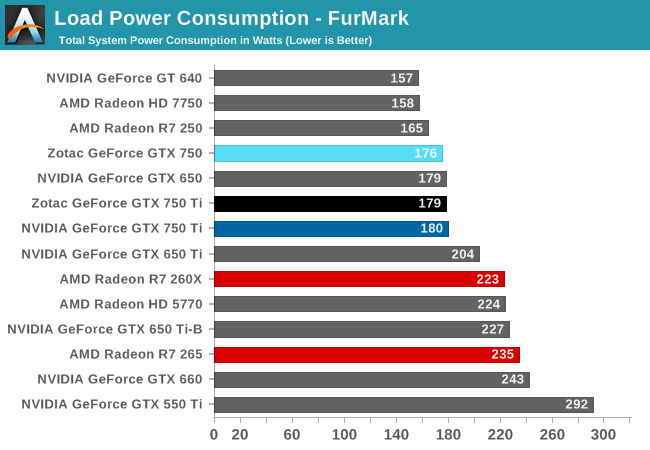


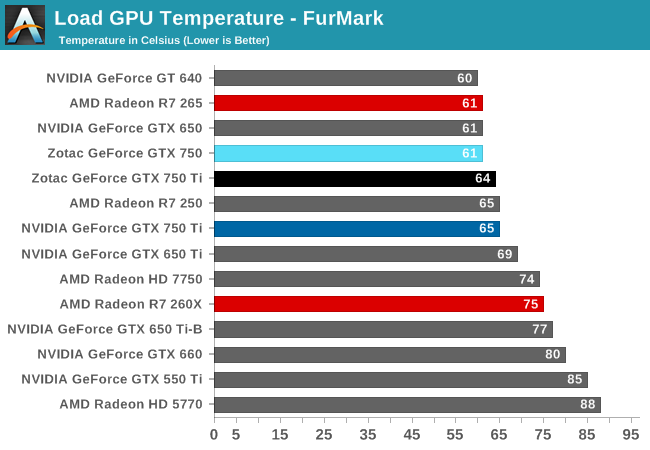
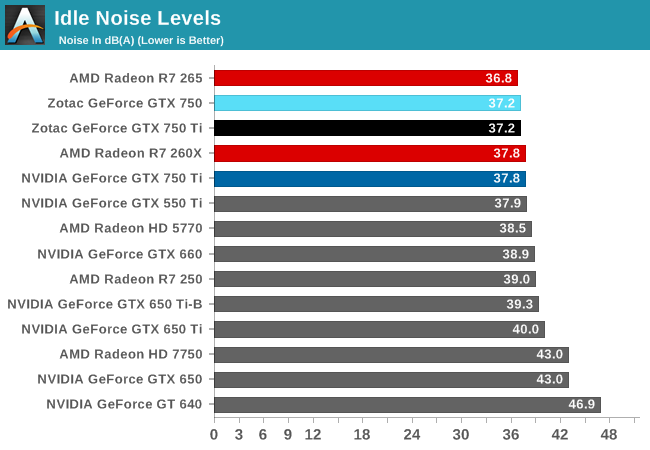
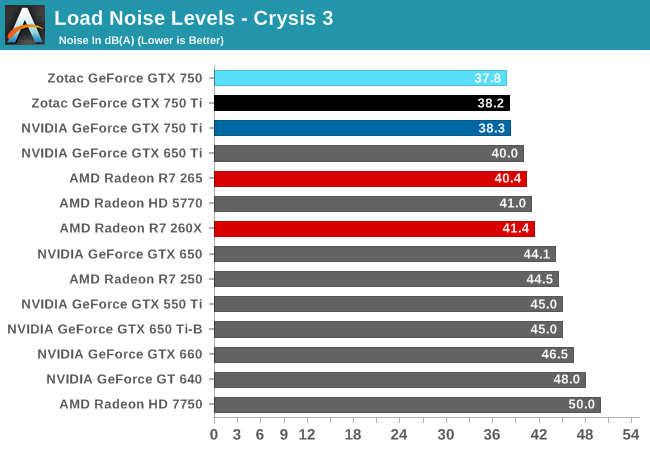
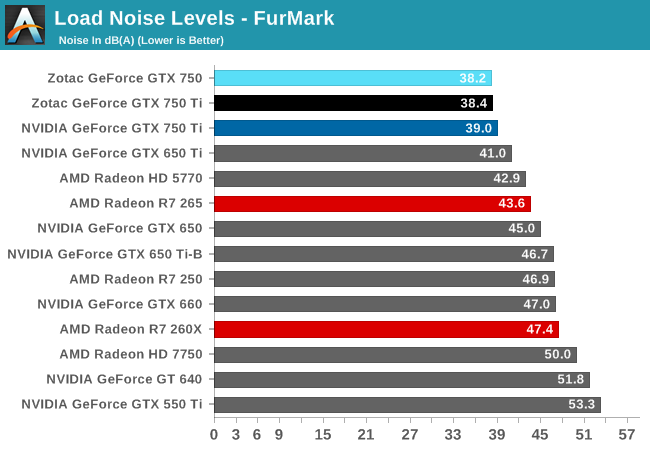










177 Comments
View All Comments
dylan522p - Tuesday, February 18, 2014 - link
They are waiting for 20nm for the entire 800 series .MugatoPdub - Tuesday, February 18, 2014 - link
Interestingly, it seems Nvidia has simply followed Intel in the "mobile first" market race, it is starting to feel as if the enthusiast will be left in the dust within the next few years =(Krysto - Tuesday, February 18, 2014 - link
Not likely, thanks to the boom in VR that we'll be seeing, which at 4k and 120fps games, will require 16x the performance we get now for games, just to play the same games, in a few years.So if anything, Nvidia should be making GPU's at the high-end that are a level or two ABOVE Titan (think 20-30 TF GPUs in 2015).
A5 - Tuesday, February 18, 2014 - link
They probably will? I'm guessing we won't see stuff below the top end (or SLI) targeted at 4K until late 2015/spring 2016, though.madmilk - Tuesday, February 18, 2014 - link
I doubt enthusiasts will be left behind, simply because HPC users will demand a 225W Tesla card. That in turn can easily sold as a 250W enthusiast card, perhaps under the Titan line.Mondozai - Wednesday, February 19, 2014 - link
Also, Nvidias desktop business is contributing to their profits and is seeing revenue growth. Their Tegra business revenue is falling almost 50% year over year.The desktop high-end GPU market will grow in good health for years to come. Their discrete laptop GPUs, however, will face doom in a relativeley short period of time as integrated GPUs performance rises to a level when most people are satisfied. Laptops specifically for gaming continues to be an unsignificant market.
jkauff - Tuesday, February 18, 2014 - link
madVR NNEDI3 uses OpenCL, and works fine on Intel and AMD boards. NVIDIA OpenCL support has been broken for the last couple of driver iterations. Please use your influence with the NVIDIA developers to get this fixed in the next driver release.IKeelU - Tuesday, February 18, 2014 - link
ugh, cryptocointexasti89 - Tuesday, February 18, 2014 - link
Wow! .. Substantially faster than 260x and consuming less than 60w using same process node. Really impressive. I can't wait to see how Maxwell arch performance & power scale at 20nm. I'm really convinced now that AMD GCN is not as efficient as many reviewers think. AMD will very likely have a hard time in this round.g101 - Tuesday, February 18, 2014 - link
*slower...Almost always slower than the 260x.... , all for power savings in the range of 5-10%...How...exciting?You should try reading the actual words that have been written in the article.